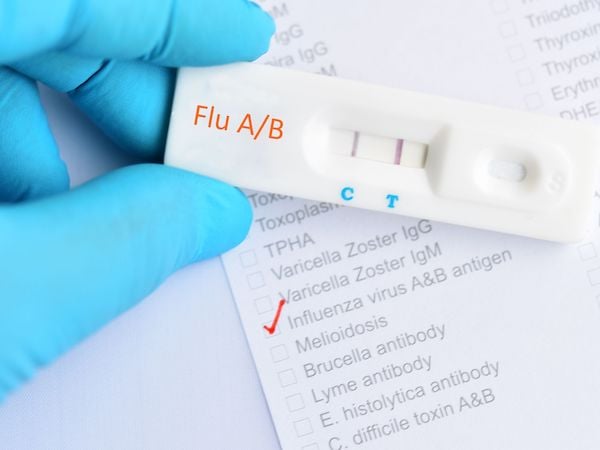
Every year, the influenza virus (a.k.a. the flu) sweeps across the globe, bringing with it a wave of illness, hospitalizations, missed days at work or school, and, at times, more severe consequences. The flu often proves to be difficult to diagnose accurately as it often resembles other illnesses – uncertainty in flu diagnoses can cause healthcare professionals to overprescribe antibiotics, under prescribe antivirals, and order unnecessary (and expensive) ancillary testing.
In this comprehensive guide, we'll dive deep into the world of the flu, shedding light on the latest in diagnosis tips, testing, and treatment. Whether you're a healthcare professional seeking the most up-to-date information or simply someone curious about how we detect the flu, this article is your go-to resource.
Let’s prepare you for flu season.
When is flu season?
In the United States, flu season typically occurs during the fall and winter months. It typically begins in October and can extend into May, with the peak of flu activity often occurring between December and February. However, the exact timing and severity of the flu season can vary from year to year.
Is the flu harmful?
The influenza virus, or flu, is far from a minor ailment. It poses a considerable threat, and the statistics underline its seriousness. Each year, the flu virus mutates, making it challenging to predict and control. While most flu cases result in mild to moderate symptoms such as fever, cough, and fatigue, its impact can be devastating. Vulnerable populations, including the very young, elderly, pregnant women, and those with underlying health conditions, face a heightened risk.
In the United States, the Centers for Disease Control and Prevention (CDC) estimates that flu-related hospitalizations have ranged from 140,000 to 810,000 annually, with flu-related deaths ranging from 12,000 to 61,000 in recent years. These numbers underscore the severe complications that can arise, such as pneumonia, hospitalization, and, tragically, death. Beyond the immediate health risks, the flu places a significant burden on healthcare systems, workplaces, and schools, resulting in widespread economic and social consequences.
What symptoms should I look out for during flu season?
When looking out for flu symptoms, be on watch for:
- Fever or feeling feverish/chills
- Cough
- Sore throat
- Runny or stuffy nose
- Muscle or body aches
- Headaches
- Fatigue (tiredness)
- Vomiting and diarrhea (more common in children)
Which leads us to…
Prepping for flu season with diagnosis tips
With flu season underway, it’s crucial for clinics, hospitals and diagnostic labs around the world to keep in stock the highest quality specimen-collection products. Even though this season shouldn't be as bad as last year's, we all know that the best defense is a good offense. As healthcare professionals know, the best way to stop the flu is with fast diagnosis and immediate treatment.
There are a number of methods for diagnosing the influenza virus. Learning the proper way to swab for the flu is crucial. High-quality products including swabs, transport media and test kits help in identifying and reducing the potential spread of influenza.
A brief history of viral cultures
For centuries, many suffered and died from what we now know was influenza. For those who were critically ill, viral culture testing was provided for enhanced treatments or epidemiology. Antivirals were very limited, and often not prescribed. Today, viral cultures continue to provide a conclusive diagnosis. But results can take 24 – 48 hours and, depending on cultures, up to 10 days. Viral culture tests are an extremely accurate and conclusive method for diagnosing influenza. Viral culture tests can determine the strain of the virus and have become the most accurate test to help identify and track the spread of the flu.
Do you have a flu season readiness plan?
Flu season is ready to roll. Can you say the same for your flu readiness plan?
Every year, the specter of a hard flu season hangs over the testing and diagnostics communities. While health officials can predict the likely timing of flu season each year, they have not developed an effective way to predict which strains of the virus will dominate. That makes developing and circulating the most effective vaccines difficult. Even when vaccines are well matched to circulating strains, CDC studies indicate, they only reduce the risk of contracting flu illness by about 40 to 60 percent.
Planning is the key to success during flu season
The resulting stress on healthcare systems falls hardest on clinical testing labs. Hardships may include increased staff workloads and elevated stress levels, strained resources, overcrowded inpatient care settings, and delays in time to diagnosis. All of this can cause a domino effect of delays in patient isolation measures and, potentially, delayed therapeutic interventions.
Specimen testing labs and POC facilities like yours can and should establish plans and policies to prevent and reduce the impact of flu season.
Plans should include:
- Visitor limitation policies
- Annual seasonal flu vaccination of staff
- Consideration of what type of vaccine was ordered vs. prevalent strains
- When and how the vaccine will be delivered to staff
Policy review should include answers to questions such as these:
- Have policies been updated for the upcoming flu season?
- Are flu-season signs and education materials available?
- Are alcohol-based hand rub, tissues, and masks available?
- Are healthcare workers discouraged from coming to work sick?
- How do you prevent the spread of flu?
Equally important as preventing and minimizing exposure to flu this season is the need to make sure your staff has the supplies and information they need to help provide the best and most accurate care possible. Puritan has that covered. Our flu resource portal gives you free access to some of the best tools available.
Now that you have a plan in place, let’s make sure you understand the diagnosis and treatment options.
Flu season: Effectively diagnose and treat influenza
Did you know that treatment for influenza is most effective when implemented just 48 hours after the onset of symptoms? Having such a short window in which to help people puts tremendous pressure on healthcare professionals. Fortunately, advancements have been made in recent years that have reduced testing turnaround time for patients.
Are you curious about the various types of tests that are available? Well, we recommend…
Point of care tests (POCTs) for flu season
Where tests were once done in batches and could take hours to yield results, random access molecular testing is now becoming more popular. These point-of-care tests (POCTs) can provide results in as little as 15 minutes.
The FDA approved the first molecular POCT for flu A/flu B—Alere's iFlu A and Flu B Test—in 2015. This test was later approved as CLIA-waived, which means the methodology used is so simple and accurate, the likelihood of erroneous test results is insignificant. Not long after, Roche's cobas® Liat Influenza A/B POCT was also developed and CLIA-waived. Not only do test results come back in 15 to 20 minutes, but further testing to confirm the analysis is not required.
Please refer to the CDC for more testing info and a complete list of approved tests.
Advantages of POCTs
As for other Advantages of POCTs, though rapid turnaround time is the most obvious upside of POC testing for influenza, there are several other advantages. In the past, diagnosis required sophisticated laboratory equipment and a highly skilled staff. But POCT specimens may be collected using a nasopharyngeal (NP), or throat swab, so conventional lab facilities are no longer necessary. Because smaller sample sizes and fewer reagents are needed, the tests can be performed in outpatient clinics, EDs, and doctor's offices. No special training for quality assurance and control is necessary.
Rapid Influenza Diagnostic Tests (RIDTs)
Today’s advanced technology provides highly effective, accurate methods for diagnosing the flu. The Reverse Transcription-Polymerase Chain Reaction (RT-PCR) affords the detection of influenza genetic material. Continued advancements have pushed Rapid Influenza Diagnostic Testing (RIDT) into virtually all levels of health care. RIDTs are used to test patients who are presenting flu-like symptoms. Depending on a patient’s circumstances and symptoms, each of these test methods could potentially be the best choice for diagnosis.
RIDTs are the fastest method for diagnosing influenza, yielding results in as little as 15 minutes. The test dictates the swab, and the test chosen will include the specimen collection swab, which may be a nasal, NP, or a throat swab. These are reliable for use in rapid testing. The advantages of fast results and ease of specimen collection make RIDTs the practical choice for front line diagnosis, allowing healthcare professionals to make prompt decisions and choices in treatments.
Factors Impacting POCT Results
Two important factors that impact test performance are patient age and the relationship between the disease stage and when the diagnostic test is performed. Adult patients shed lower amounts of virus, and do so for less time, than pediatric patients. Consequently, the accuracy of POCT for influenza in adults is higher when they present to their healthcare provider soon after the onset of symptoms.
The type of specimen tested can also have an effect on test results. There are different specifications for different influenza POCTs, depending on whether the specimen is collected by nasopharyngeal, nasal, or throat swab. It's critical that the package insert in the test be followed to the letter, as some require sample collection using a special swab.
Your healthcare professional will test in accordance with the specifications provided with the kit.
The ease of specimen collection and quick turnaround time of RIDTs allow professionals to make prompt decisions in treatments. Considering how unforgiving the flu can be, point-of-care testing seems more and more like the practical choice for flu diagnosis.
The best swabs for flu season
Puritan’s PurFlock Ultra® flocked swabs were designed for use with our UniTranz-RT® Media Transport Systems. They are ideal for test methods that require viral culture, RT-PCR, and RIDT, and they’re offered in 1ml or 3ml fills with a variety of swab styles to accommodate specific uses.
For nasopharyngeal (NP) swab specimens: your best choice is either mini-tip or ultrafine flocked swabs. The standard tipped swab affords greater ease and additional tip surface area in the collection of throat specimens.
UniTranz-RT® universal transport media used in conjunction with PurFlock Ultra® flocked swabs, once validated, provide superior specimen collection, transport, and elution compared with traditional spun swabs, delivering the specimen optimum for the test methodology of choice.
Why Buy Swabs from Puritan?
The pioneers of precision - For over four decades, Puritan Medical Products has mastered the art of crafting application-specific medical swabs. Trust the industry leaders for impeccable quality.
Want to learn more about our manufacturing processes and what type of swabs we offer? Get in touch with our team today.



